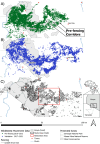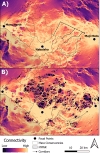Predicting the impact of targeted fence removal on connectivity in a migratory ecosystem
- PMID: 39868640
- PMCID: PMC11771689
- DOI: 10.1002/eap.3094
Predicting the impact of targeted fence removal on connectivity in a migratory ecosystem
Abstract
Fencing is one of the most widely utilized tools for reducing human-wildlife conflict in agricultural landscapes. However, the increasing global footprint of fencing exceeds millions of kilometers and has unintended consequences for wildlife, including habitat fragmentation, movement restriction, entanglement, and mortality. Here, we present a novel and quantitative approach to prioritize fence removal within historic migratory pathways of white-bearded wildebeest (Connochaetes taurinus) across Kenya's Greater Masai Mara Ecosystem. Our approach first assesses historic and contemporary landscape connectivity of wildebeest between seasonal ranges by incorporating two sets of GPS tracking data and fine-scale fencing data. We then predict connectivity gains from simulated fence removal and evaluate the impact of different corridor widths and locations on connectivity and removal costs derived from locally implemented interventions. Within the study system, we found that modest levels of fence removal resulted in substantial connectivity gains (39%-54% improvement in connectivity for 15-140 km of fence line removed). By identifying the most suitable corridor site, we show that strategically placed narrow corridors outperform larger, more expensive interventions. Our results demonstrate how and where targeted fence removal can enhance connectivity for wildlife. Our framework can aid in identifying suitable and cost-effective corridor restoration sites to guide decision-makers on the removal of fences and other linear barriers. Our approach is transferable to other landscapes where the removal or modification of fences or similar barriers is a feasible mitigation strategy to restore habitat and migratory connectivity.
Keywords: Circuitscape; East Africa; connectivity; corridors; fencing; grassland restoration; land‐use change; linear barriers; migration; pastoralism; ungulates; wildebeest.
© 2025 The Author(s). Ecological Applications published by Wiley Periodicals LLC on behalf of The Ecological Society of America.
Conflict of interest statement
The authors declare no conflicts of interest.
Figures






References
-
- Bartlam‐Brooks, H. L. A. , Bonyongo M. C., and Harris S.. 2011. “Will Reconnecting Ecosystems Allow Long‐Distance Mammal Migrations to Resume? A Case Study of a Zebra Equus Burchelli Migration in Botswana.” Oryx 45(2): 210–216. 10.1017/S0030605310000414. - DOI
-
- Bartoń, K. 2022. “MuMIn: Multi‐Model Inference.” R Package Version 1.46.0. https://CRAN.R-project.org/package=MuMIn.
-
- Bartzke, G. S. , Ogutu J. O., Mukhopadhyay S., Mtui D., Dublin H. T., and Piepho H.‐P.. 2018. “Rainfall Trends and Variation in the Maasai Mara Ecosystem and their Implications for Animal Population and Biodiversity Dynamics.” PLoS One 13: e0202814. 10.1371/journal.pone.0202814. - DOI - PMC - PubMed
-
- Bates, D. , Mächler M., Bolker B., and Walker S.. 2015. “Fitting Linear Mixed‐Effects Models Using lme4.” Journal of Statistical Software 67(1): 1–48. 10.18637/jss.v067.i01. - DOI
MeSH terms
Grants and funding
LinkOut - more resources
Full Text Sources

